We passed by villagers heading back from the weekly haat, market, in Kodenar. Women balanced empty vessels on their heads which had ferried local brews mahua and salfi that morning. Men veered drunkenly towards the middle of the road, tilted their heads in the opposite direction attempting to tread a straight line. Those on bicycles held their prized fighter cocks in the cradle of their arms more tenderly than the women their babies. It was a rough, dusty lane and most of them were barefoot. They all hurried to their homes beyond the hills as dusk fell fast. I too hurtled along on the pillion seat of Dharam’s motorcycle whose horn the years had mercifully shrunk to a toady chortle. Speedbreakers sprang up unannounced, in pairs: at the beginning and end of every four or forty-hut hamlet, outside entry and exit gates – usually the same – of schools and police stations, before and after bridges and at times houses even – that belonged to the sarpanch or some other local biggie. For the first time since my overland travels through Chhattisgarh began over a month ago I began to appreciate the true purpose behind the twin-hump policy: if the first one flung you off your seat, the second put you back on. This was actually a realisation that dawned with resignation: Dharam, like the rest of the lads of the state, hit a cautious 40 kmph on highways but flew over un-tarred, pebble-strewn village roads. It was their backyard and they were frightfully good at ripping it. They just looked ahead in frozen incomprehension if you asked them to take it easy. Besides the omnipresent puncture shop had to be kept in business.
I had understood the futility of asking Dharam to slow down that morning itself as we began our journey headed for Tamraghumar, a less known and seen waterfalls, 18 kilometres away from its more famous and voluminous neighbour Chitrakote. En route we had stopped by the scenic rocky outcrops of Mendrighumar where Dharam had none-too-subtly announced ‘My parents are my past, my kid is my future. I am my present and I live in the present.’ He said it with the literary flourish of his master degree in Hindi language. So probably he might have said he believed in living up the present. Whatever, the idea was infectious and strangely it brought up mahua and salfi and the virtues of imbibing fresh country liquor on empty stomachs. Soon enough we were in a village set away from the road with haphazardly arranged adobe houses next to each other. The only life about were a bunch of spindly boys in frayed sweaters finding immense amusement shoving each other to the ground. ‘Shankar’ called out Dharam to them and soon they all disappeared into the nearby house. ‘Very friendly,’ I said. Almost immediately a fleshy little chap in a purple tee shirt and matching shorts emerged rubbing his eyes at the head of the kids who ran in earlier. Shankar came with us on the bike and took us to another house with a well-kept yard at the front where a lady hurried about busily from the kitchen to the cattle shed to the chicken coop and back. ‘In Chhattisgarh the women do all the work,’ Dharam pointed out to me. She paused for just a moment taking stock of our requirements and quickly and methodically laid a mat on the yard, arranged steel glasses, brought the clear brew in a steel jug, and gave us each a handful of raw channa, chickpeas. This, I was informed as a matter of great import, was sold to the tribal folks of the state for five rupees a kilo while the rest of the people had to pay forty. What worried me more at that time was the safety of my already broken teeth.
Mahua for the road was filled in a plastic bottle by the busy lady who was back to her rounds. Shankar refused money but gratefully downed the glass I gave him in one swig. ‘My hero,’ I acknowledged genuinely with my hand over my heart. Later we drank some sitting on the ledge overlooking the Tamraghumar Falls, some we mixed with the cool water gurgling toward the leap. We screamed with excitement at the discovery of a new drink. Locals carried felled trees over their shoulders, like Arnie in Commando, splashing across the cataract. When you are having fun the last thing you want to do is head back. Barsoor was 45 kilometres away and the ride would be through thick forest, home of the ‘uncles’ – how the locals referred to the Naxals. Did I want to do it? Just as Dharam promised we didn’t see a single vehicle during the entire stretch till we reached Barsoor. He had also said we wouldn’t see even a bird – which I bravely attributed to the thick canopy of the jungle. The mahua had magical properties – it gave me the courage to sing outside the shower for the first time and Dharam the fortitude to bear with it. We played Antakshari all the way to Barsoor. I guess deep inside I was hoping the uncles would realise I wasn’t worth the trouble. Along some of the more shady patches, I saw wooden slabs, daubed with a coat of white paint that rose from the ground with childish illustrations on them. Dharam told me that these were memorials and the figures depicted the life of the dead one, a sort of pictorial summing up. It wasn’t as easy or flippant as it looked and a lot of thought and discussion and definitely fond memories went in here: one memorial to a lad who died aged 25 years showed an ostensibly jovial guy pedalling a cycle seated on the carrier. On another was a policeman brandishing a rifle while a man lay bleeding on the ground. Under the circumstances we were not sure which of these two was buried here. All of these slabs were topped with carved wooden headers resembling a bear head or fish or cockerel. Being winter months, a few even had blankets draped over them. Didn’t matter who was dead – they were all missed.
The theme continued into Barsoor where the town began from a junction marked by a memorial to the soldiers killed in the Kargil War of 1999. The helmet-over-bayonet was painted an indecipherable black which didn’t do much by way of solemnity for the sheen. An earlier memorial to the dead jawans, a slide-shaped stone pillar by the side of the road, stood blackened by the soot from the hotel next to it. A water hose ran nonchalantly over it and next to it were makeshift benches of stone slabs where customers sat. We too took our slabs and had masala dosa, samosa and tea. Repeat: like in most of the dhabas I ate at Chhattisgarh the food was delish. The potato-onion-mirchi mix which formed the masala of the dosa was squished into the top, wet side of the batter on the tawa. The Dasaprakash of dhabas. But what really zapped me was the owner’s son who served us. While the best I received so far for a ‘thank you’ was an appreciative grunt here I was rewarded with a ‘welcome’ loud and clear, topped with a smile. Good food and great people were among my top three lures of Chhattisgarh. Mayoral elections were round the corner and the town was abuzz; rival party candidates smiled unconvincingly at voters out of posters hands clasped in a namesake Namaste. Promises set to popular Bollywood disco numbers from the 80s blared out from PA systems with candidate names and symbol descriptions thrown in. Bappi Lahiri rediscovered. Women and children marched insipidly, waving flags, clueless of the affiliations they were led to chant. I was told there was a lavish lunch waiting for them at the candidate’s house. There would be mahua too but it wasn’t good enough to get the guys to tag along these days; they wanted ‘bottle’ – whiskey or rum.
Forty kilometres further on was Dantewada which makes headlines for plenty of wrong reasons. But from where we sat across the road we could see an unbroken line of lush undulating hills where Naxals roamed freely. The road wound through the middle of spillover shanties of Barsoor and was well maintained. Two Central Reserve Police Force checkposts screened everyone passing through; the second one was before a bridge over the Indrawati River which led directly into the forest. This one was guarded by bulletproof-vested security personnel bleary-eyed from long unblinking hours. Apparently the Naxals weren’t happy with the access the bridge provided the Force and wanted to blow it up. We rode across and stopped by a small shrine where the tarred stretch ended and an arduous climb began over red rolling stones and bauxite-laden soil. A couple of guys came by on a bike and just stood staring at us. I had seen them at the dhaba at Barsoor and remembered I had left my empty mahua bottle there; we were to fill it with salfi. I peered closely at them to see if they were there to give me back the bottle. Dharam started his bike – he usually started his bike after I sat, which I guess was a way of saving gas – and turned it around before asking me to get on. ‘Don’t stare at them like that,’ he told me as soon as we were out of earshot. ‘Were they uncles?’ I asked. ‘Why do you think they followed us from the dhaba?’ he asked. ‘Do you know them?’ He didn’t but apparently nobody else took more than a nodding interest in visitors passing through.
On our way to Dantewada, we stopped by a small town called Gidam where people still took off their footwear before entering shops and sat down tatami-style as the sales people laid out their wares. A barber with a fancy haircut informed me that he got his hair cut from Raipur, state capital. ‘There’s nobody else in Gidam.’ I was delighted to find a shop that stocked Fanta; I hadn’t seen it in any of the big cities and very rarely came across it since my school days in Nigeria. Déjà vu washed over me in waves with each sugared, non-fruit pulpy, orangey gulp. I stuck my tongue out at Dharam like I did at my sisters back then; Dharam told me his three-year-old son too did the same. The last 10 kilometres into Dantewada was being re-laid into a double-lane with arching neon lights that looked too far above to be of much use. New buildings lay vacant and windowless by the main road. Barbed wire fences sprung around residential quarters of defence personnel families, sentries peeped out of watchtowers erected on four corners of the compound. Few kids were out with their grandparents, rolled into layers of colourful sweaters, among the see-saws and swings. The town was on high alert since five Naxals – carrying lakhs of rupee rewards on their heads – had laid down their arms a week earlier. In the past Naxals had killed, if not the surrendered Naxals then their kin, for what they deemed act of betrayal. Dantewada was also trying to reinvent itself. ‘Dantewada is all set to be the education hub of the district, possibly the whole of south Chhattisgarh,’ Maharaja Kamal Chandra Bhanj Deo of Bastar had informed me earlier. Which probably explained the buildings by the road. Dharam stripped down to his underwear and jumped into the Dankini River to bathe before entering the famous Danteshwari Temple on the banks. He brought coconut-and-sugar prasad from the temple in an orange bag. Afterwards we had steaming khichdi – rice and dal – served in leaf plates sold from a nearby building for five and ten rupees. I was hungry and wolfed down a ten rupee serving.
Kodenar a little town tucked between mined-out mountains was my first haat in Chhattisgarh. Over the next few days, through the haats of Lohandiguda, Chingitarai, Pamela and Tokapal – some of them I was warned to be wary of – I was to become an ardent follower of cockfights and an addict of khidkhidi, a gambling involving giant dices within an upturned basket. Losing money on both fronts. At Kodenar I marvelled at the kind of money that changed hands, the furious din that rose with every fight and ended abruptly sometimes just a few seconds later, the nonchalance with which the owner of the dead cockerel took the defeat, now looking for buyers for the dead meat. The ban on cockfights across many haats by ‘civic’ authorities met with little success for the sociological function it performs. ‘The tribals of Chhattisgarh are primarily hunters and warriors and the cockfights provide them the much-needed vent in their otherwise non-happening lives,’ says Awesh Ali who has been taking tourists around Bastar for over a decade now. Domestic violence was unheard of in those parts and women called the shots around the house. The women stayed away from the cockfight – they sold country liquor and fried and curried chicken and fish. And manned vegetable shops. They also eyed their cheering menfolk crowding around the arena with indulgent smiles. The din grew loud, a fight had broken out: both cockerels had fallen at the same time. Dharam started his bike and turned it around before telling me to climb on.


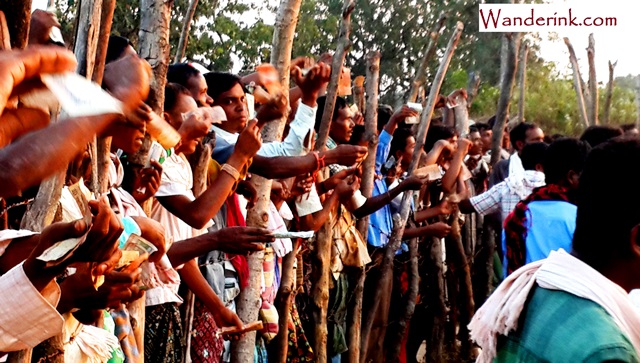
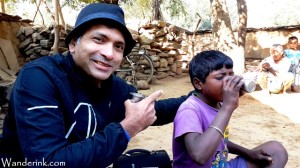

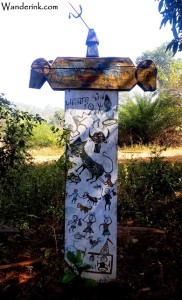
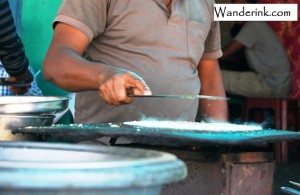
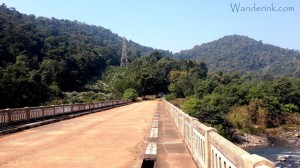
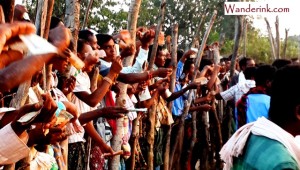
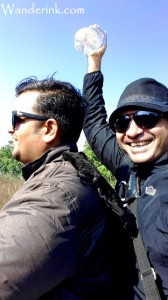









Wow! What an experience. But dosa in Chattisgarh?
Yes, thanks. Then there are also idlis, albeit a fried variety and even the ‘barra’ a permutation of the vada.
Quite a ride, that. Made for a great read too. Way to go!
Thanks a bunch, Puneet. Glad you liked the read/ride. 🙂